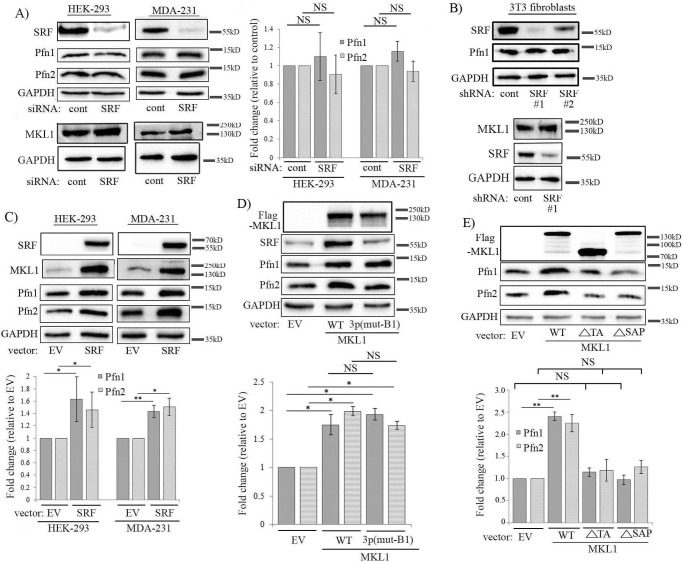Figure 3.
MKL regulates Pfn expression likely through an SRF-independent SAP domain-directed function. A, immunoblot analyses of MKL1, SRF, Pfn1, Pfn2, and GAPDH (loading control) expression in HEK-293 and MDA-231 cells 72 h after transient transfection with either control or SRF-siRNA (bar graph shows quantification (mean ± S.D.) of immunoblot data summarized from three independent experiments; NS, not significant). B, left, immunoblot analyses of SRF, Pfn1, and GAPDH (loading control) expression in control versus SRF-shRNA-expressing mouse 3T3 fibroblasts (two independent SRF shRNA stable clones (#1, #2) are shown); data are representative of two independent experiments; right, immunoblot analyses of MKL1 expression in control versus SRF-shRNA (#1) expressers of 3T3 cells. C, immunoblot analyses of SRF, MKL1, Pfn1, and Pfn2 expression in HEK-293 and MDA-231 cells 48 h after transfection with either SRF overexpression vector or empty vector (EV) as control. Images of SRF bands were acquired at a very low exposure (0.05 s) to prevent saturation of the SRF overexpression lane signal, which prevented the endogenous SRF band from being detected. The bar graph shows the mean ± S.D. values of the fold-changes in Pfn1 and Pfn2 expression with respect to the corresponding empty vector control transfection condition. D and E, immunoblot analyses of lysates of HEK-293 cells showing the effects of overexpression of either WT versus 3p(mut-B1) mutant form of MKL1 (D) or WT versus various deletion mutants form of MKL1 (E) on Pfn expression (3p(mut-B1), K237A/Y238A/H239A; ΔSAP = deletion of amino acids 343–378; ΔTA = a truncated form consisting of the first 630 amino acids); all MKL1 constructs are FLAG-tagged. The bar graphs show the mean ± S.D. values of the fold-changes in Pfn1 and Pfn2 expression with respect to the corresponding empty vector control transfection conditions. All data are summarized from three independent experiments; **, p < 0.01; *, p < 0.05; NS, not significant). GAPDH blots serve as the loading control.

